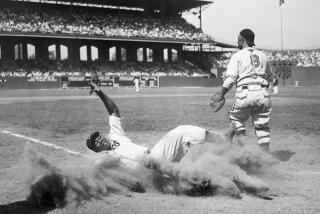History Lesson for Everyone
- Share via
Black History Month rolls in this weekend with little hoopla from the world of sports.
It’s not a round, catchy number of years since Jackie Robinson broke baseball’s color line, so we probably won’t hear much about him--as if 51 years of integration is any less significant than 50.
At least baseball, in one of those rare instances where the bungleheads that run the sport got something right, did its best to ensure that everyone who ever picked up a bat knows Robinson’s story.
All too often the knowledge ends there, when it really should be just the beginning. Everything else gets lost in the back of books, sealed off from the current generation.
Walk into a football or basketball locker room, ask the black players who first made it possible for them to play that sport and you’ll get a bunch of blank stares. The only historical figures they can name are Benjamin Franklin, Andrew Jackson and anyone else whose face appears on money.
Condemn them for their ignorance, but save a few stones for the rest of us who have failed to teach them. Where is the emphasis on history?
The NBA is the most African American-dominated team sport around--80% of its players are black--but it doesn’t do enough to recognize its black pioneers or acknowledge its past. In its otherwise masterful nostalgia-fest to celebrate the league’s 50th anniversary last season, the NBA paid scant attention to pioneers such as Chuck Cooper, the first African American player selected in the draft, or Earl Lloyd, the first to play in a game.
We always hear about Bill Russell’s 11 championship rings, but rarely are we reminded that he also was the NBA’s first black head coach.
The NBA tipped off last season with the New York Knicks playing the Raptors in Toronto, the same city where the first game of the NBA’s forerunner, the Basketball Assn. of America, was played exactly 50 years earlier. The teams wore throwback uniforms. Only they forgot one thing. If they really wanted to make it authentic, no black players would have been allowed on the court.
We need to look at the bleakest periods of the past to understand how good we have it today. The significance of a black coach, Tubby Smith, at Kentucky would be lost without the memories of segregationist Adolph Rupp coaching his all-white Kentucky team against the all-black starting five of Texas Western in the 1966 NCAA championship game.
An official NCAA tournament book’s list of milestones deems the first attendance by a sitting president in 1991 noteworthy, but the most important changes it revealed for 1966 was “Net income for the entire tournament exceeded $500,000 for the first time” and “A television-blackout provision requiring a 48-hour advance sellout was adopted.”
You can’t tell history and leave out the parts that hurt. Swallow hard, accept the truth, and move on.
I went to the civil rights museum in Birmingham, Ala., on an off day during the 1995 NCAA tournament regionals. The last room of the museum plays a lengthy audio excerpt from Martin Luther King’s “I Have a Dream” speech. But it’s missing the part when he talks about “Mississippi, sweltering in the heat of oppression” and “Alabama, with its vicious racists.”
Those words are edited out, without any explanation, other than the assumption that they didn’t want to remind the locals of the way they were. But when a black kid leaves the museum, how is he supposed to appreciate his carefree walk through the same park where Bull Connor set attack dogs on marchers?
A friend of mine wondered if today’s black athletes would be any better off if they knew the names of their predecessors. Obviously, not knowing hasn’t hurt their pocketbooks, but there’s an intellectual void that’s growing. They don’t feel a part of something special that has been given to them, they don’t recognize that opportunities to make this lucrative living were provided for by people who had to endure harassment, both physical and verbal.
Most of the people who paid the price don’t have stadiums or streets named after them. Their only recognition comes in speeches and books, so it’s up to us to keep their names going.
That’s why it was so great to hear Tiger Woods thank Charlie Sifford and Lee Elder after he won the Masters. Maybe it came from his heart and maybe it came from the mouth of a savvy PR person. Either way, it was important for Woods and everyone else to realize that he didn’t win the Masters on his own.
Maybe some of the new fans Woods brought to golf heard the names of two of golf’s black trailblazers and want to learn more about them.
Their task will not be as easy as it should be.
I walked into a large bookstore Friday and could not find two must-reads for sports fans: Arthur Ashe’s encyclopedic account of black sports pioneers, “Hard Road to Glory” or Nelson George’s “Elevating the Game,” which examines how African Americans changed the sport of basketball.
Plenty of copies of Dennis Rodman’s “Bad as I Wanna Be,” though, and that pretty much sums up where we are right now.
More to Read
Go beyond the scoreboard
Get the latest on L.A.'s teams in the daily Sports Report newsletter.
You may occasionally receive promotional content from the Los Angeles Times.










